Improving Student Retention at Higher Education Institutions: A Report
VerifiedAdded on 2022/11/07
|25
|6611
|484
Report
AI Summary
This report investigates student retention issues in Higher Education Institutions (HEIs), with a particular focus on the sense of belonging. It examines the impact of pre-sessional programs on student retention, attendance, submission, and continuation rates. The report uses GSM London as a case study, analyzing its student demographics and retention data. It explores the effectiveness of various support mechanisms and innovative curriculum designs. The report also includes reflections on assessment practices, including formal and informal assessment tools, and their influence on student learning. The study aims to create and strengthen the sense of belonging on the part of the students as well as improves the retention of the students. The report draws on theories from Tinto and others, analyzing case studies and key research questions to assess the impact of pre-sessional programs on student success and overall institutional performance.
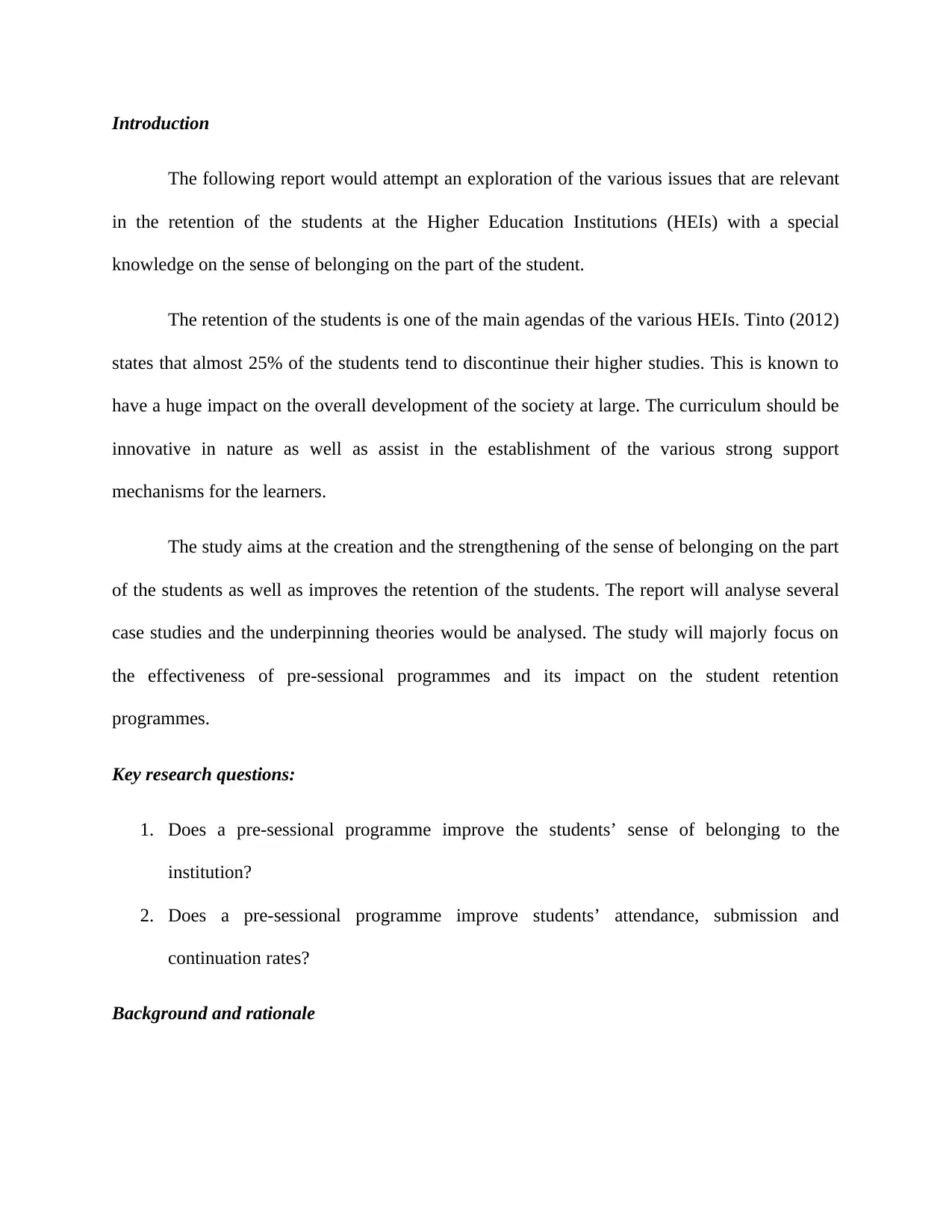
Introduction
The following report would attempt an exploration of the various issues that are relevant
in the retention of the students at the Higher Education Institutions (HEIs) with a special
knowledge on the sense of belonging on the part of the student.
The retention of the students is one of the main agendas of the various HEIs. Tinto (2012)
states that almost 25% of the students tend to discontinue their higher studies. This is known to
have a huge impact on the overall development of the society at large. The curriculum should be
innovative in nature as well as assist in the establishment of the various strong support
mechanisms for the learners.
The study aims at the creation and the strengthening of the sense of belonging on the part
of the students as well as improves the retention of the students. The report will analyse several
case studies and the underpinning theories would be analysed. The study will majorly focus on
the effectiveness of pre-sessional programmes and its impact on the student retention
programmes.
Key research questions:
1. Does a pre-sessional programme improve the students’ sense of belonging to the
institution?
2. Does a pre-sessional programme improve students’ attendance, submission and
continuation rates?
Background and rationale
The following report would attempt an exploration of the various issues that are relevant
in the retention of the students at the Higher Education Institutions (HEIs) with a special
knowledge on the sense of belonging on the part of the student.
The retention of the students is one of the main agendas of the various HEIs. Tinto (2012)
states that almost 25% of the students tend to discontinue their higher studies. This is known to
have a huge impact on the overall development of the society at large. The curriculum should be
innovative in nature as well as assist in the establishment of the various strong support
mechanisms for the learners.
The study aims at the creation and the strengthening of the sense of belonging on the part
of the students as well as improves the retention of the students. The report will analyse several
case studies and the underpinning theories would be analysed. The study will majorly focus on
the effectiveness of pre-sessional programmes and its impact on the student retention
programmes.
Key research questions:
1. Does a pre-sessional programme improve the students’ sense of belonging to the
institution?
2. Does a pre-sessional programme improve students’ attendance, submission and
continuation rates?
Background and rationale
Paraphrase This Document
Need a fresh take? Get an instant paraphrase of this document with our AI Paraphraser
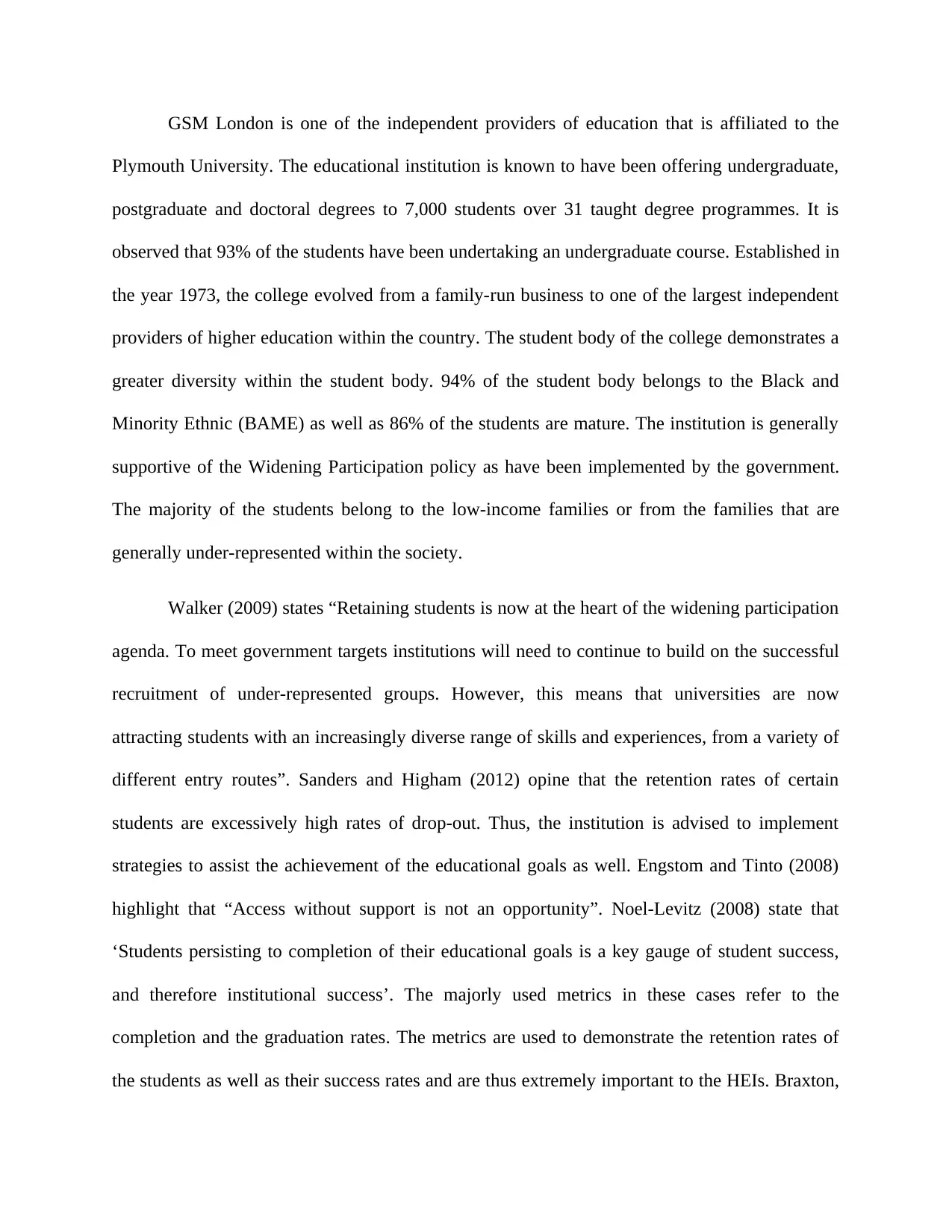
GSM London is one of the independent providers of education that is affiliated to the
Plymouth University. The educational institution is known to have been offering undergraduate,
postgraduate and doctoral degrees to 7,000 students over 31 taught degree programmes. It is
observed that 93% of the students have been undertaking an undergraduate course. Established in
the year 1973, the college evolved from a family-run business to one of the largest independent
providers of higher education within the country. The student body of the college demonstrates a
greater diversity within the student body. 94% of the student body belongs to the Black and
Minority Ethnic (BAME) as well as 86% of the students are mature. The institution is generally
supportive of the Widening Participation policy as have been implemented by the government.
The majority of the students belong to the low-income families or from the families that are
generally under-represented within the society.
Walker (2009) states “Retaining students is now at the heart of the widening participation
agenda. To meet government targets institutions will need to continue to build on the successful
recruitment of under-represented groups. However, this means that universities are now
attracting students with an increasingly diverse range of skills and experiences, from a variety of
different entry routes”. Sanders and Higham (2012) opine that the retention rates of certain
students are excessively high rates of drop-out. Thus, the institution is advised to implement
strategies to assist the achievement of the educational goals as well. Engstom and Tinto (2008)
highlight that “Access without support is not an opportunity”. Noel-Levitz (2008) state that
‘Students persisting to completion of their educational goals is a key gauge of student success,
and therefore institutional success’. The majorly used metrics in these cases refer to the
completion and the graduation rates. The metrics are used to demonstrate the retention rates of
the students as well as their success rates and are thus extremely important to the HEIs. Braxton,
Plymouth University. The educational institution is known to have been offering undergraduate,
postgraduate and doctoral degrees to 7,000 students over 31 taught degree programmes. It is
observed that 93% of the students have been undertaking an undergraduate course. Established in
the year 1973, the college evolved from a family-run business to one of the largest independent
providers of higher education within the country. The student body of the college demonstrates a
greater diversity within the student body. 94% of the student body belongs to the Black and
Minority Ethnic (BAME) as well as 86% of the students are mature. The institution is generally
supportive of the Widening Participation policy as have been implemented by the government.
The majority of the students belong to the low-income families or from the families that are
generally under-represented within the society.
Walker (2009) states “Retaining students is now at the heart of the widening participation
agenda. To meet government targets institutions will need to continue to build on the successful
recruitment of under-represented groups. However, this means that universities are now
attracting students with an increasingly diverse range of skills and experiences, from a variety of
different entry routes”. Sanders and Higham (2012) opine that the retention rates of certain
students are excessively high rates of drop-out. Thus, the institution is advised to implement
strategies to assist the achievement of the educational goals as well. Engstom and Tinto (2008)
highlight that “Access without support is not an opportunity”. Noel-Levitz (2008) state that
‘Students persisting to completion of their educational goals is a key gauge of student success,
and therefore institutional success’. The majorly used metrics in these cases refer to the
completion and the graduation rates. The metrics are used to demonstrate the retention rates of
the students as well as their success rates and are thus extremely important to the HEIs. Braxton,
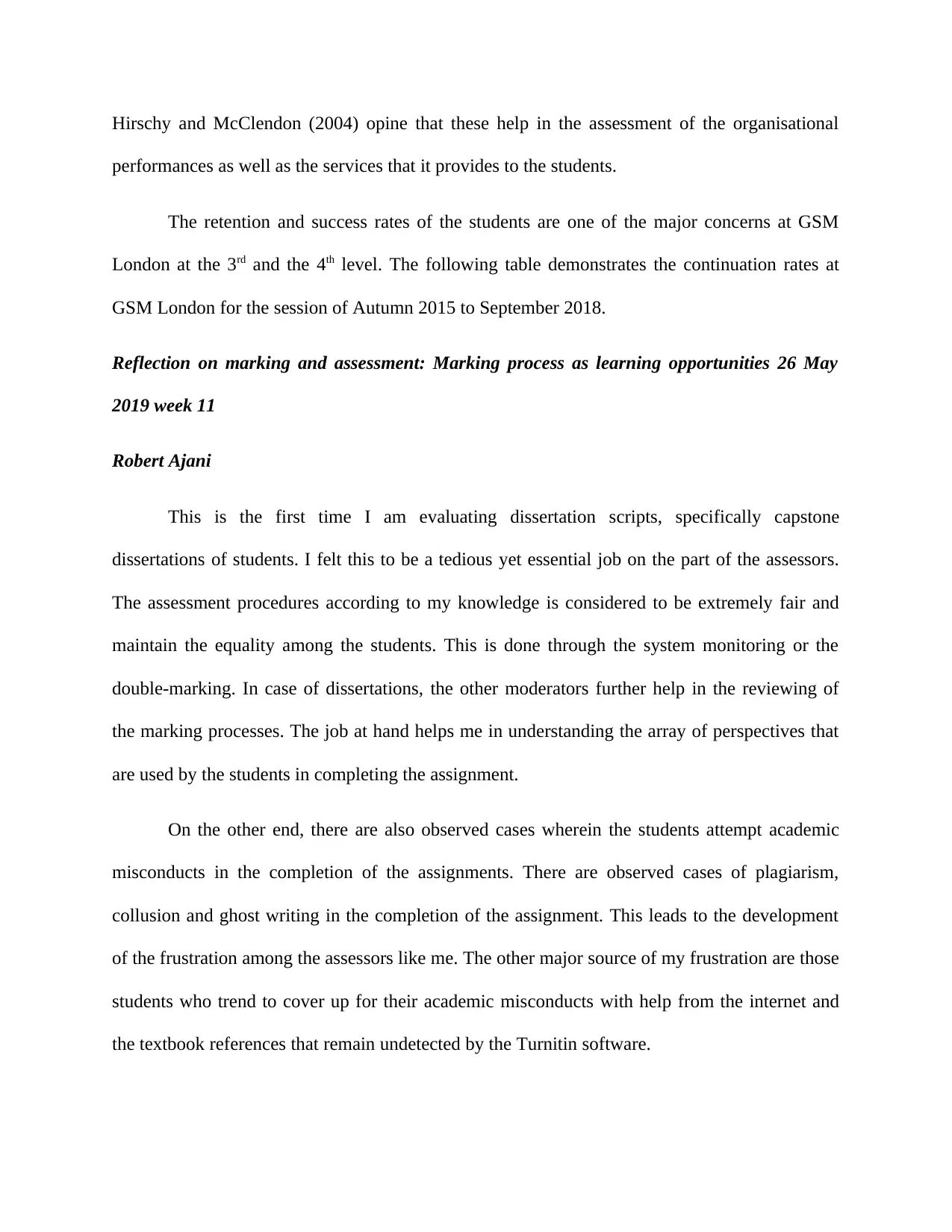
Hirschy and McClendon (2004) opine that these help in the assessment of the organisational
performances as well as the services that it provides to the students.
The retention and success rates of the students are one of the major concerns at GSM
London at the 3rd and the 4th level. The following table demonstrates the continuation rates at
GSM London for the session of Autumn 2015 to September 2018.
Reflection on marking and assessment: Marking process as learning opportunities 26 May
2019 week 11
Robert Ajani
This is the first time I am evaluating dissertation scripts, specifically capstone
dissertations of students. I felt this to be a tedious yet essential job on the part of the assessors.
The assessment procedures according to my knowledge is considered to be extremely fair and
maintain the equality among the students. This is done through the system monitoring or the
double-marking. In case of dissertations, the other moderators further help in the reviewing of
the marking processes. The job at hand helps me in understanding the array of perspectives that
are used by the students in completing the assignment.
On the other end, there are also observed cases wherein the students attempt academic
misconducts in the completion of the assignments. There are observed cases of plagiarism,
collusion and ghost writing in the completion of the assignment. This leads to the development
of the frustration among the assessors like me. The other major source of my frustration are those
students who trend to cover up for their academic misconducts with help from the internet and
the textbook references that remain undetected by the Turnitin software.
performances as well as the services that it provides to the students.
The retention and success rates of the students are one of the major concerns at GSM
London at the 3rd and the 4th level. The following table demonstrates the continuation rates at
GSM London for the session of Autumn 2015 to September 2018.
Reflection on marking and assessment: Marking process as learning opportunities 26 May
2019 week 11
Robert Ajani
This is the first time I am evaluating dissertation scripts, specifically capstone
dissertations of students. I felt this to be a tedious yet essential job on the part of the assessors.
The assessment procedures according to my knowledge is considered to be extremely fair and
maintain the equality among the students. This is done through the system monitoring or the
double-marking. In case of dissertations, the other moderators further help in the reviewing of
the marking processes. The job at hand helps me in understanding the array of perspectives that
are used by the students in completing the assignment.
On the other end, there are also observed cases wherein the students attempt academic
misconducts in the completion of the assignments. There are observed cases of plagiarism,
collusion and ghost writing in the completion of the assignment. This leads to the development
of the frustration among the assessors like me. The other major source of my frustration are those
students who trend to cover up for their academic misconducts with help from the internet and
the textbook references that remain undetected by the Turnitin software.
⊘ This is a preview!⊘
Do you want full access?
Subscribe today to unlock all pages.

Trusted by 1+ million students worldwide
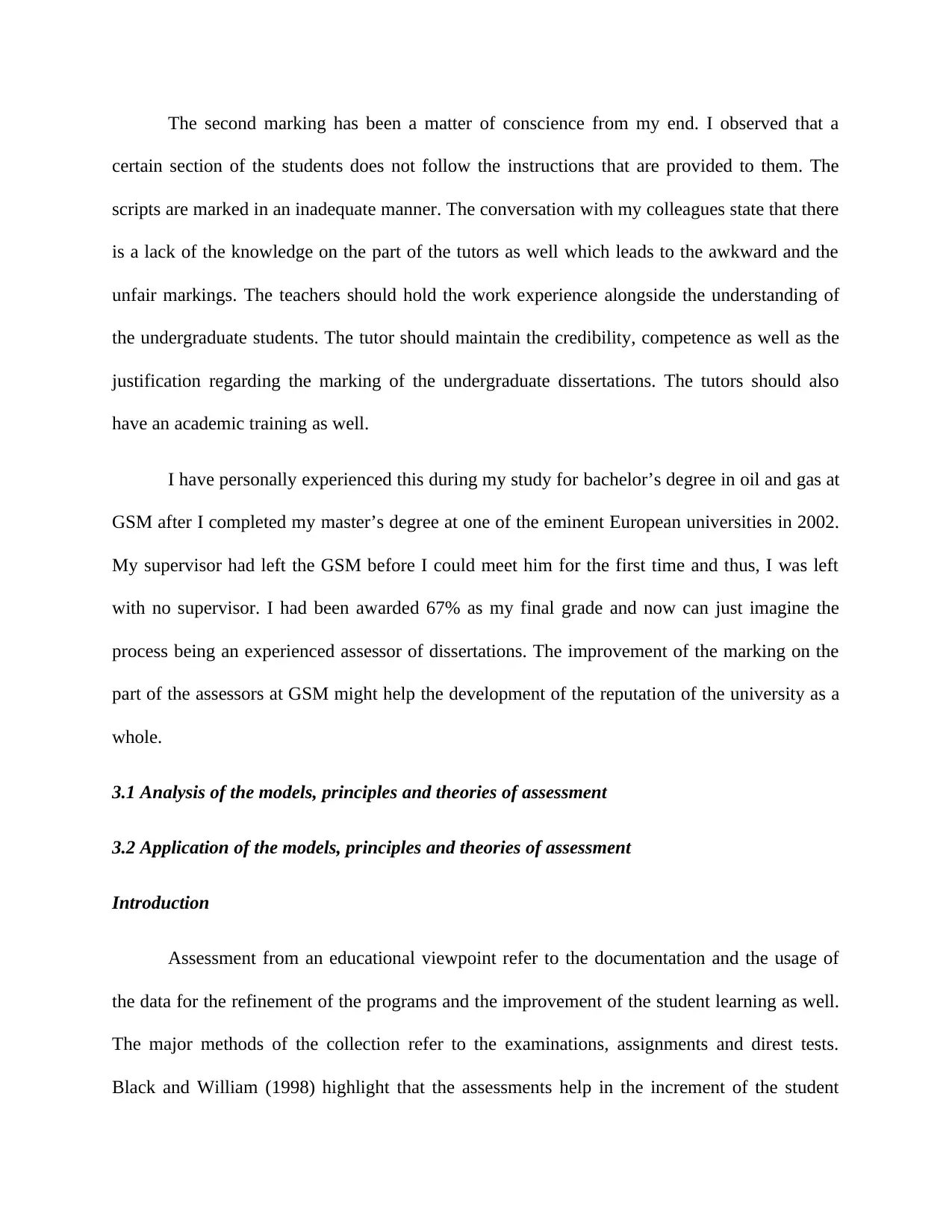
The second marking has been a matter of conscience from my end. I observed that a
certain section of the students does not follow the instructions that are provided to them. The
scripts are marked in an inadequate manner. The conversation with my colleagues state that there
is a lack of the knowledge on the part of the tutors as well which leads to the awkward and the
unfair markings. The teachers should hold the work experience alongside the understanding of
the undergraduate students. The tutor should maintain the credibility, competence as well as the
justification regarding the marking of the undergraduate dissertations. The tutors should also
have an academic training as well.
I have personally experienced this during my study for bachelor’s degree in oil and gas at
GSM after I completed my master’s degree at one of the eminent European universities in 2002.
My supervisor had left the GSM before I could meet him for the first time and thus, I was left
with no supervisor. I had been awarded 67% as my final grade and now can just imagine the
process being an experienced assessor of dissertations. The improvement of the marking on the
part of the assessors at GSM might help the development of the reputation of the university as a
whole.
3.1 Analysis of the models, principles and theories of assessment
3.2 Application of the models, principles and theories of assessment
Introduction
Assessment from an educational viewpoint refer to the documentation and the usage of
the data for the refinement of the programs and the improvement of the student learning as well.
The major methods of the collection refer to the examinations, assignments and direst tests.
Black and William (1998) highlight that the assessments help in the increment of the student
certain section of the students does not follow the instructions that are provided to them. The
scripts are marked in an inadequate manner. The conversation with my colleagues state that there
is a lack of the knowledge on the part of the tutors as well which leads to the awkward and the
unfair markings. The teachers should hold the work experience alongside the understanding of
the undergraduate students. The tutor should maintain the credibility, competence as well as the
justification regarding the marking of the undergraduate dissertations. The tutors should also
have an academic training as well.
I have personally experienced this during my study for bachelor’s degree in oil and gas at
GSM after I completed my master’s degree at one of the eminent European universities in 2002.
My supervisor had left the GSM before I could meet him for the first time and thus, I was left
with no supervisor. I had been awarded 67% as my final grade and now can just imagine the
process being an experienced assessor of dissertations. The improvement of the marking on the
part of the assessors at GSM might help the development of the reputation of the university as a
whole.
3.1 Analysis of the models, principles and theories of assessment
3.2 Application of the models, principles and theories of assessment
Introduction
Assessment from an educational viewpoint refer to the documentation and the usage of
the data for the refinement of the programs and the improvement of the student learning as well.
The major methods of the collection refer to the examinations, assignments and direst tests.
Black and William (1998) highlight that the assessments help in the increment of the student
Paraphrase This Document
Need a fresh take? Get an instant paraphrase of this document with our AI Paraphraser
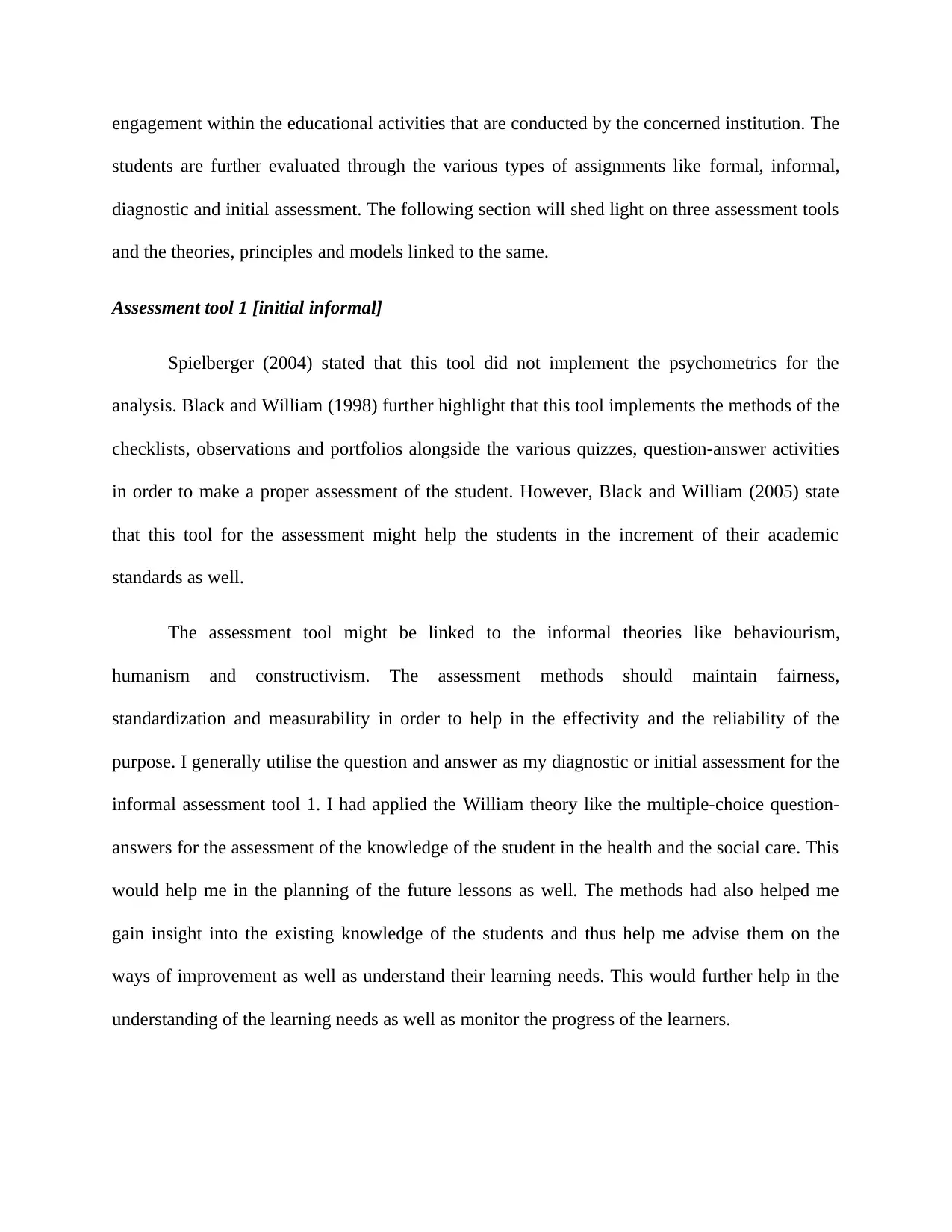
engagement within the educational activities that are conducted by the concerned institution. The
students are further evaluated through the various types of assignments like formal, informal,
diagnostic and initial assessment. The following section will shed light on three assessment tools
and the theories, principles and models linked to the same.
Assessment tool 1 [initial informal]
Spielberger (2004) stated that this tool did not implement the psychometrics for the
analysis. Black and William (1998) further highlight that this tool implements the methods of the
checklists, observations and portfolios alongside the various quizzes, question-answer activities
in order to make a proper assessment of the student. However, Black and William (2005) state
that this tool for the assessment might help the students in the increment of their academic
standards as well.
The assessment tool might be linked to the informal theories like behaviourism,
humanism and constructivism. The assessment methods should maintain fairness,
standardization and measurability in order to help in the effectivity and the reliability of the
purpose. I generally utilise the question and answer as my diagnostic or initial assessment for the
informal assessment tool 1. I had applied the William theory like the multiple-choice question-
answers for the assessment of the knowledge of the student in the health and the social care. This
would help me in the planning of the future lessons as well. The methods had also helped me
gain insight into the existing knowledge of the students and thus help me advise them on the
ways of improvement as well as understand their learning needs. This would further help in the
understanding of the learning needs as well as monitor the progress of the learners.
students are further evaluated through the various types of assignments like formal, informal,
diagnostic and initial assessment. The following section will shed light on three assessment tools
and the theories, principles and models linked to the same.
Assessment tool 1 [initial informal]
Spielberger (2004) stated that this tool did not implement the psychometrics for the
analysis. Black and William (1998) further highlight that this tool implements the methods of the
checklists, observations and portfolios alongside the various quizzes, question-answer activities
in order to make a proper assessment of the student. However, Black and William (2005) state
that this tool for the assessment might help the students in the increment of their academic
standards as well.
The assessment tool might be linked to the informal theories like behaviourism,
humanism and constructivism. The assessment methods should maintain fairness,
standardization and measurability in order to help in the effectivity and the reliability of the
purpose. I generally utilise the question and answer as my diagnostic or initial assessment for the
informal assessment tool 1. I had applied the William theory like the multiple-choice question-
answers for the assessment of the knowledge of the student in the health and the social care. This
would help me in the planning of the future lessons as well. The methods had also helped me
gain insight into the existing knowledge of the students and thus help me advise them on the
ways of improvement as well as understand their learning needs. This would further help in the
understanding of the learning needs as well as monitor the progress of the learners.
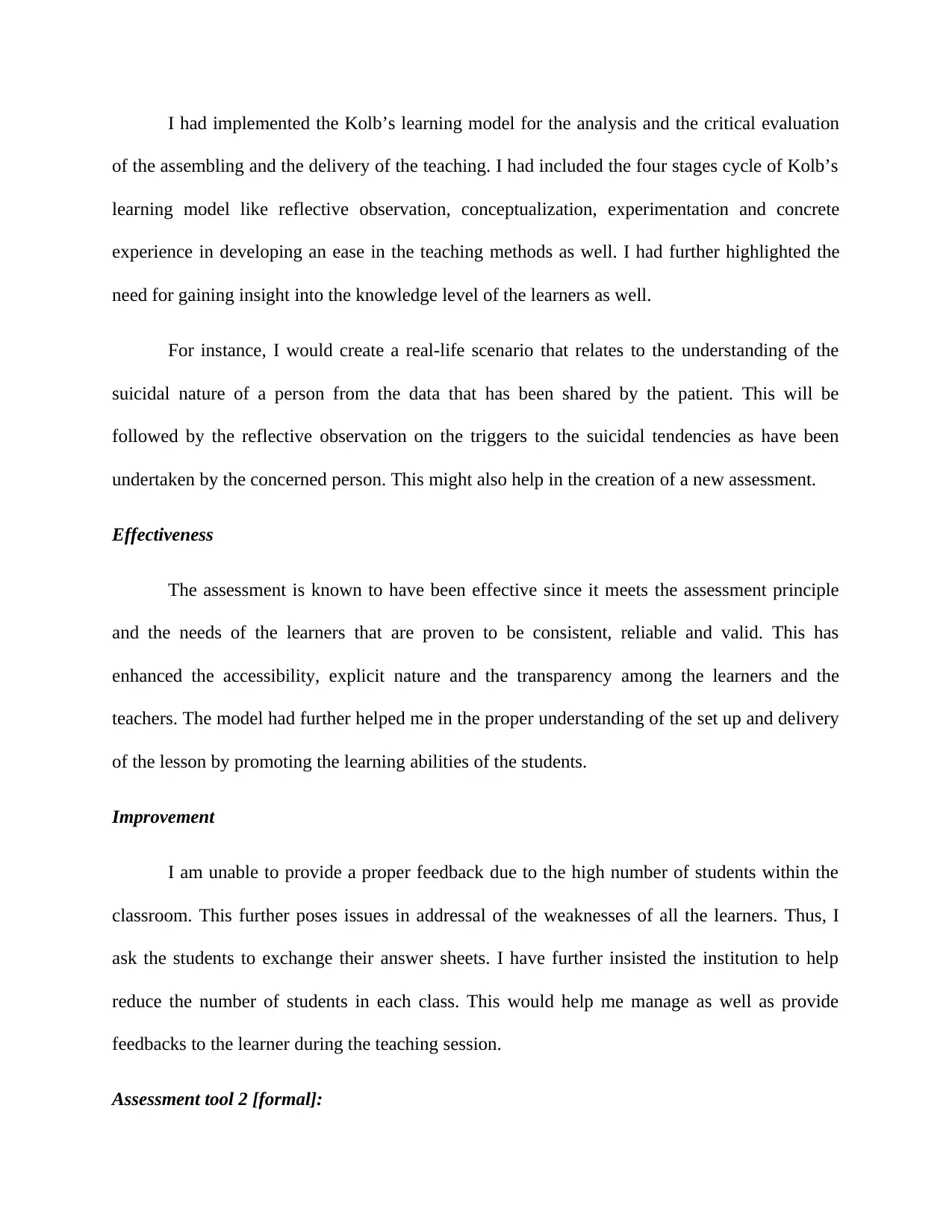
I had implemented the Kolb’s learning model for the analysis and the critical evaluation
of the assembling and the delivery of the teaching. I had included the four stages cycle of Kolb’s
learning model like reflective observation, conceptualization, experimentation and concrete
experience in developing an ease in the teaching methods as well. I had further highlighted the
need for gaining insight into the knowledge level of the learners as well.
For instance, I would create a real-life scenario that relates to the understanding of the
suicidal nature of a person from the data that has been shared by the patient. This will be
followed by the reflective observation on the triggers to the suicidal tendencies as have been
undertaken by the concerned person. This might also help in the creation of a new assessment.
Effectiveness
The assessment is known to have been effective since it meets the assessment principle
and the needs of the learners that are proven to be consistent, reliable and valid. This has
enhanced the accessibility, explicit nature and the transparency among the learners and the
teachers. The model had further helped me in the proper understanding of the set up and delivery
of the lesson by promoting the learning abilities of the students.
Improvement
I am unable to provide a proper feedback due to the high number of students within the
classroom. This further poses issues in addressal of the weaknesses of all the learners. Thus, I
ask the students to exchange their answer sheets. I have further insisted the institution to help
reduce the number of students in each class. This would help me manage as well as provide
feedbacks to the learner during the teaching session.
Assessment tool 2 [formal]:
of the assembling and the delivery of the teaching. I had included the four stages cycle of Kolb’s
learning model like reflective observation, conceptualization, experimentation and concrete
experience in developing an ease in the teaching methods as well. I had further highlighted the
need for gaining insight into the knowledge level of the learners as well.
For instance, I would create a real-life scenario that relates to the understanding of the
suicidal nature of a person from the data that has been shared by the patient. This will be
followed by the reflective observation on the triggers to the suicidal tendencies as have been
undertaken by the concerned person. This might also help in the creation of a new assessment.
Effectiveness
The assessment is known to have been effective since it meets the assessment principle
and the needs of the learners that are proven to be consistent, reliable and valid. This has
enhanced the accessibility, explicit nature and the transparency among the learners and the
teachers. The model had further helped me in the proper understanding of the set up and delivery
of the lesson by promoting the learning abilities of the students.
Improvement
I am unable to provide a proper feedback due to the high number of students within the
classroom. This further poses issues in addressal of the weaknesses of all the learners. Thus, I
ask the students to exchange their answer sheets. I have further insisted the institution to help
reduce the number of students in each class. This would help me manage as well as provide
feedbacks to the learner during the teaching session.
Assessment tool 2 [formal]:
⊘ This is a preview!⊘
Do you want full access?
Subscribe today to unlock all pages.

Trusted by 1+ million students worldwide
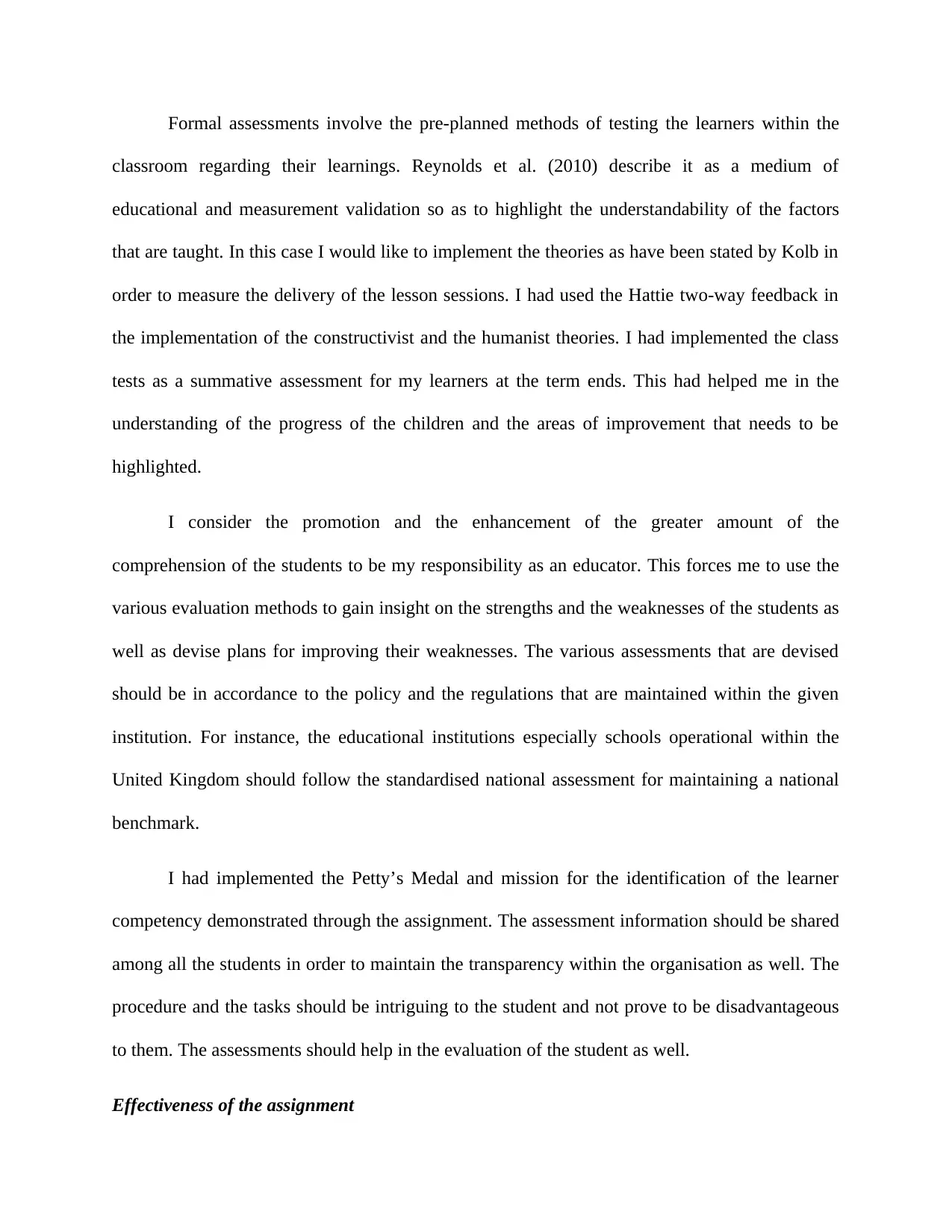
Formal assessments involve the pre-planned methods of testing the learners within the
classroom regarding their learnings. Reynolds et al. (2010) describe it as a medium of
educational and measurement validation so as to highlight the understandability of the factors
that are taught. In this case I would like to implement the theories as have been stated by Kolb in
order to measure the delivery of the lesson sessions. I had used the Hattie two-way feedback in
the implementation of the constructivist and the humanist theories. I had implemented the class
tests as a summative assessment for my learners at the term ends. This had helped me in the
understanding of the progress of the children and the areas of improvement that needs to be
highlighted.
I consider the promotion and the enhancement of the greater amount of the
comprehension of the students to be my responsibility as an educator. This forces me to use the
various evaluation methods to gain insight on the strengths and the weaknesses of the students as
well as devise plans for improving their weaknesses. The various assessments that are devised
should be in accordance to the policy and the regulations that are maintained within the given
institution. For instance, the educational institutions especially schools operational within the
United Kingdom should follow the standardised national assessment for maintaining a national
benchmark.
I had implemented the Petty’s Medal and mission for the identification of the learner
competency demonstrated through the assignment. The assessment information should be shared
among all the students in order to maintain the transparency within the organisation as well. The
procedure and the tasks should be intriguing to the student and not prove to be disadvantageous
to them. The assessments should help in the evaluation of the student as well.
Effectiveness of the assignment
classroom regarding their learnings. Reynolds et al. (2010) describe it as a medium of
educational and measurement validation so as to highlight the understandability of the factors
that are taught. In this case I would like to implement the theories as have been stated by Kolb in
order to measure the delivery of the lesson sessions. I had used the Hattie two-way feedback in
the implementation of the constructivist and the humanist theories. I had implemented the class
tests as a summative assessment for my learners at the term ends. This had helped me in the
understanding of the progress of the children and the areas of improvement that needs to be
highlighted.
I consider the promotion and the enhancement of the greater amount of the
comprehension of the students to be my responsibility as an educator. This forces me to use the
various evaluation methods to gain insight on the strengths and the weaknesses of the students as
well as devise plans for improving their weaknesses. The various assessments that are devised
should be in accordance to the policy and the regulations that are maintained within the given
institution. For instance, the educational institutions especially schools operational within the
United Kingdom should follow the standardised national assessment for maintaining a national
benchmark.
I had implemented the Petty’s Medal and mission for the identification of the learner
competency demonstrated through the assignment. The assessment information should be shared
among all the students in order to maintain the transparency within the organisation as well. The
procedure and the tasks should be intriguing to the student and not prove to be disadvantageous
to them. The assessments should help in the evaluation of the student as well.
Effectiveness of the assignment
Paraphrase This Document
Need a fresh take? Get an instant paraphrase of this document with our AI Paraphraser

The above discussed method is considered to be effective, timeless and reliable in nature.
The observation from my end had been effective in nature and helped in the identification of the
of the commitment of the students as well as assisted in devising the learning of the students.
Improvement
The improvement of the assessment methods requires a reflection on the performance and
the learning strategies that are adopted for the improvement of the feedback that I provide to the
students. This would help me meet the needs of the students and the other forms of the
assessments.
Assessment tool 3
The technology has helped in the reshaping of the education processes. This has helped in
the development of the processes of knowledge acquirement and the assessment methods. This
has a huge effect on the administration of the assessments. I implement the online training in the
delivering the lessons which in turn enables the students to access the lecture materials for the
completion of the assessments. This also enables me to understand the various issues that are
highlighted by the students as well provide feedback to the students.
The feedback is known to have been a two-way traffic in order to provide a justification
the essence of the factor. The teachers and the students might have an exchange of the
assessments and grade through the online medium. This has helped me in increasing the
effectiveness of the assessment and the incorporation of the feedback of the learner as well. This
method helps in the active participation of the learners within the given organisation.
Principle
The observation from my end had been effective in nature and helped in the identification of the
of the commitment of the students as well as assisted in devising the learning of the students.
Improvement
The improvement of the assessment methods requires a reflection on the performance and
the learning strategies that are adopted for the improvement of the feedback that I provide to the
students. This would help me meet the needs of the students and the other forms of the
assessments.
Assessment tool 3
The technology has helped in the reshaping of the education processes. This has helped in
the development of the processes of knowledge acquirement and the assessment methods. This
has a huge effect on the administration of the assessments. I implement the online training in the
delivering the lessons which in turn enables the students to access the lecture materials for the
completion of the assessments. This also enables me to understand the various issues that are
highlighted by the students as well provide feedback to the students.
The feedback is known to have been a two-way traffic in order to provide a justification
the essence of the factor. The teachers and the students might have an exchange of the
assessments and grade through the online medium. This has helped me in increasing the
effectiveness of the assessment and the incorporation of the feedback of the learner as well. This
method helps in the active participation of the learners within the given organisation.
Principle
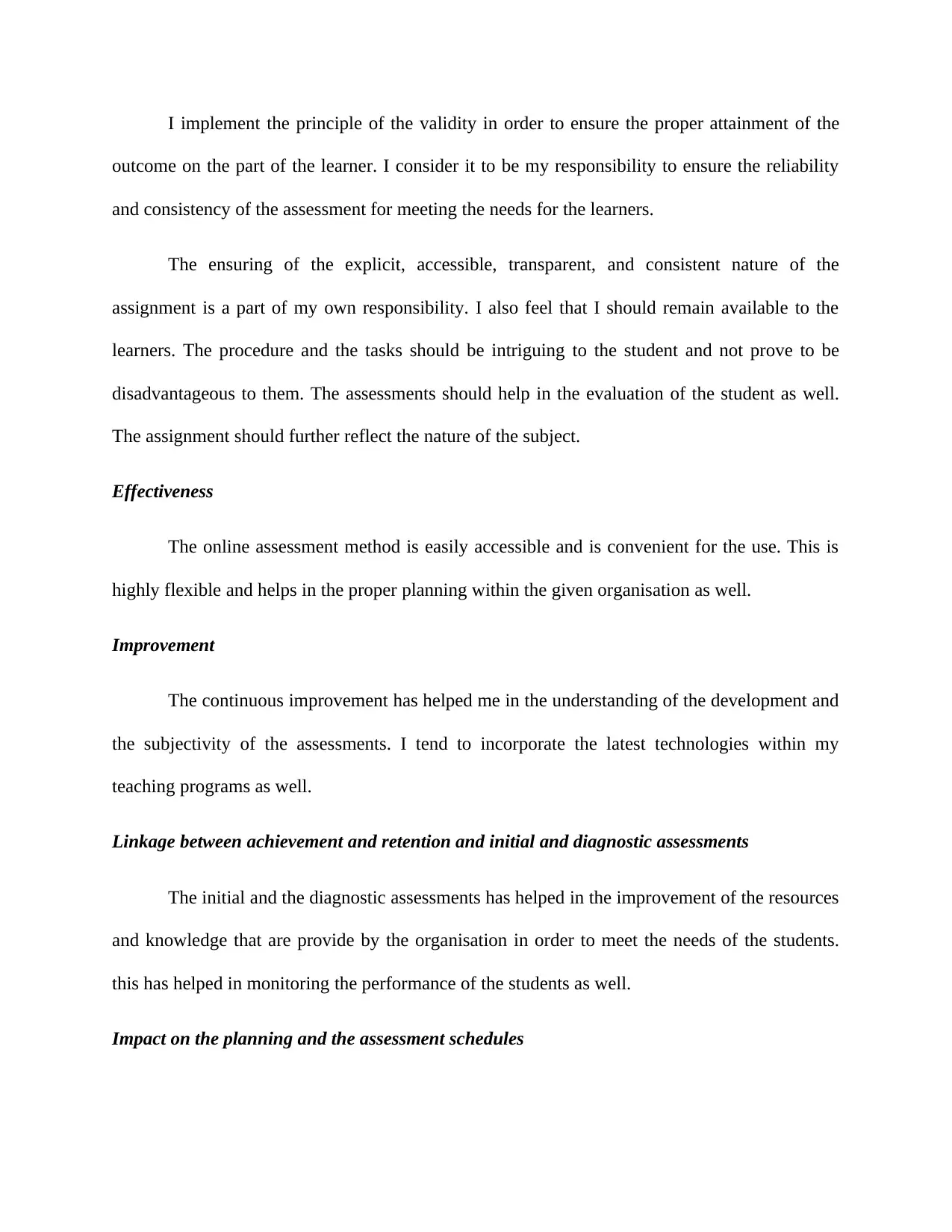
I implement the principle of the validity in order to ensure the proper attainment of the
outcome on the part of the learner. I consider it to be my responsibility to ensure the reliability
and consistency of the assessment for meeting the needs for the learners.
The ensuring of the explicit, accessible, transparent, and consistent nature of the
assignment is a part of my own responsibility. I also feel that I should remain available to the
learners. The procedure and the tasks should be intriguing to the student and not prove to be
disadvantageous to them. The assessments should help in the evaluation of the student as well.
The assignment should further reflect the nature of the subject.
Effectiveness
The online assessment method is easily accessible and is convenient for the use. This is
highly flexible and helps in the proper planning within the given organisation as well.
Improvement
The continuous improvement has helped me in the understanding of the development and
the subjectivity of the assessments. I tend to incorporate the latest technologies within my
teaching programs as well.
Linkage between achievement and retention and initial and diagnostic assessments
The initial and the diagnostic assessments has helped in the improvement of the resources
and knowledge that are provide by the organisation in order to meet the needs of the students.
this has helped in monitoring the performance of the students as well.
Impact on the planning and the assessment schedules
outcome on the part of the learner. I consider it to be my responsibility to ensure the reliability
and consistency of the assessment for meeting the needs for the learners.
The ensuring of the explicit, accessible, transparent, and consistent nature of the
assignment is a part of my own responsibility. I also feel that I should remain available to the
learners. The procedure and the tasks should be intriguing to the student and not prove to be
disadvantageous to them. The assessments should help in the evaluation of the student as well.
The assignment should further reflect the nature of the subject.
Effectiveness
The online assessment method is easily accessible and is convenient for the use. This is
highly flexible and helps in the proper planning within the given organisation as well.
Improvement
The continuous improvement has helped me in the understanding of the development and
the subjectivity of the assessments. I tend to incorporate the latest technologies within my
teaching programs as well.
Linkage between achievement and retention and initial and diagnostic assessments
The initial and the diagnostic assessments has helped in the improvement of the resources
and knowledge that are provide by the organisation in order to meet the needs of the students.
this has helped in monitoring the performance of the students as well.
Impact on the planning and the assessment schedules
⊘ This is a preview!⊘
Do you want full access?
Subscribe today to unlock all pages.

Trusted by 1+ million students worldwide

The learner portfolio contains all the sample work that can be used in the development of
the overall reporting of the assessment and the various reporting processes. The teacher would
provide the strategies in order to solve the problems in case of the learner’s risk assessments. The
portfolio would also hold individual learning goals, assessment schedules in order to demonstrate
a time efficiency. The institution is capable of planning effective assessment for students as per
their knowledge and skill levels.
Reliability
I learned about the importance of the referencing in order to enhance the reliability of the
task. I further gained better knowledge on the designing of knowledgeable assignments in the
development of the students.
I further ensured that the students learned majorly about the research methods like the use
of internet and the textbooks in the composition of the assignment at large.
Task 4
4.1 Models and theories related to development and curriculum
4.2 Application of models and theories related to development and curriculum
Curriculum defined
Iwasiw et al. (2009) opine that the “Curriculum development in nursing education helps
nurses educators create a program of study that will meet the contextual needs of their
individual setting’’. Thus, the curriculum might be defined as a lesson plan jointly put together
by teachers knowledgeable about the topic for the overall benefit of the course for the learners to
achieve the learning outcome. The assessments are generally used for the determining the ability
the overall reporting of the assessment and the various reporting processes. The teacher would
provide the strategies in order to solve the problems in case of the learner’s risk assessments. The
portfolio would also hold individual learning goals, assessment schedules in order to demonstrate
a time efficiency. The institution is capable of planning effective assessment for students as per
their knowledge and skill levels.
Reliability
I learned about the importance of the referencing in order to enhance the reliability of the
task. I further gained better knowledge on the designing of knowledgeable assignments in the
development of the students.
I further ensured that the students learned majorly about the research methods like the use
of internet and the textbooks in the composition of the assignment at large.
Task 4
4.1 Models and theories related to development and curriculum
4.2 Application of models and theories related to development and curriculum
Curriculum defined
Iwasiw et al. (2009) opine that the “Curriculum development in nursing education helps
nurses educators create a program of study that will meet the contextual needs of their
individual setting’’. Thus, the curriculum might be defined as a lesson plan jointly put together
by teachers knowledgeable about the topic for the overall benefit of the course for the learners to
achieve the learning outcome. The assessments are generally used for the determining the ability
Paraphrase This Document
Need a fresh take? Get an instant paraphrase of this document with our AI Paraphraser
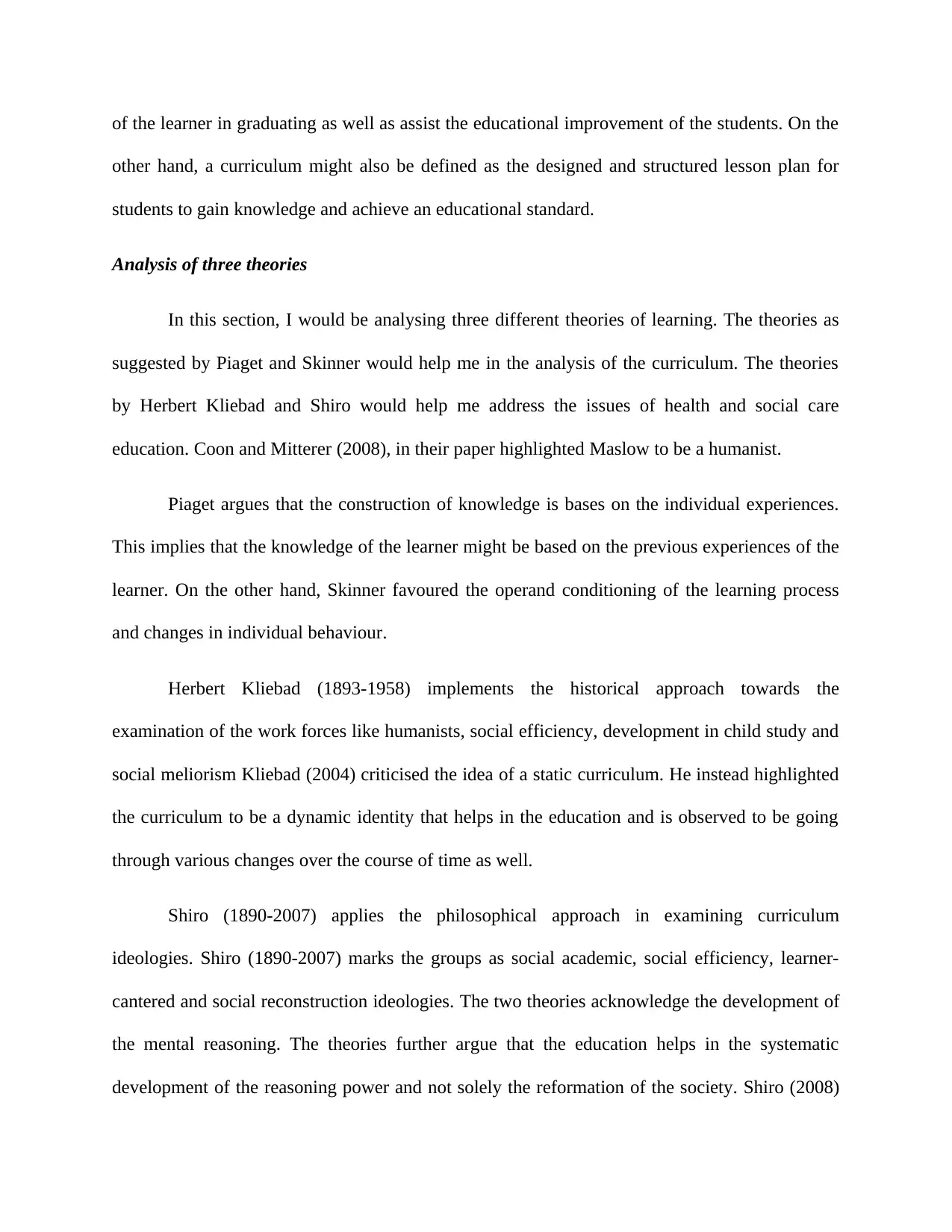
of the learner in graduating as well as assist the educational improvement of the students. On the
other hand, a curriculum might also be defined as the designed and structured lesson plan for
students to gain knowledge and achieve an educational standard.
Analysis of three theories
In this section, I would be analysing three different theories of learning. The theories as
suggested by Piaget and Skinner would help me in the analysis of the curriculum. The theories
by Herbert Kliebad and Shiro would help me address the issues of health and social care
education. Coon and Mitterer (2008), in their paper highlighted Maslow to be a humanist.
Piaget argues that the construction of knowledge is bases on the individual experiences.
This implies that the knowledge of the learner might be based on the previous experiences of the
learner. On the other hand, Skinner favoured the operand conditioning of the learning process
and changes in individual behaviour.
Herbert Kliebad (1893-1958) implements the historical approach towards the
examination of the work forces like humanists, social efficiency, development in child study and
social meliorism Kliebad (2004) criticised the idea of a static curriculum. He instead highlighted
the curriculum to be a dynamic identity that helps in the education and is observed to be going
through various changes over the course of time as well.
Shiro (1890-2007) applies the philosophical approach in examining curriculum
ideologies. Shiro (1890-2007) marks the groups as social academic, social efficiency, learner-
cantered and social reconstruction ideologies. The two theories acknowledge the development of
the mental reasoning. The theories further argue that the education helps in the systematic
development of the reasoning power and not solely the reformation of the society. Shiro (2008)
other hand, a curriculum might also be defined as the designed and structured lesson plan for
students to gain knowledge and achieve an educational standard.
Analysis of three theories
In this section, I would be analysing three different theories of learning. The theories as
suggested by Piaget and Skinner would help me in the analysis of the curriculum. The theories
by Herbert Kliebad and Shiro would help me address the issues of health and social care
education. Coon and Mitterer (2008), in their paper highlighted Maslow to be a humanist.
Piaget argues that the construction of knowledge is bases on the individual experiences.
This implies that the knowledge of the learner might be based on the previous experiences of the
learner. On the other hand, Skinner favoured the operand conditioning of the learning process
and changes in individual behaviour.
Herbert Kliebad (1893-1958) implements the historical approach towards the
examination of the work forces like humanists, social efficiency, development in child study and
social meliorism Kliebad (2004) criticised the idea of a static curriculum. He instead highlighted
the curriculum to be a dynamic identity that helps in the education and is observed to be going
through various changes over the course of time as well.
Shiro (1890-2007) applies the philosophical approach in examining curriculum
ideologies. Shiro (1890-2007) marks the groups as social academic, social efficiency, learner-
cantered and social reconstruction ideologies. The two theories acknowledge the development of
the mental reasoning. The theories further argue that the education helps in the systematic
development of the reasoning power and not solely the reformation of the society. Shiro (2008)
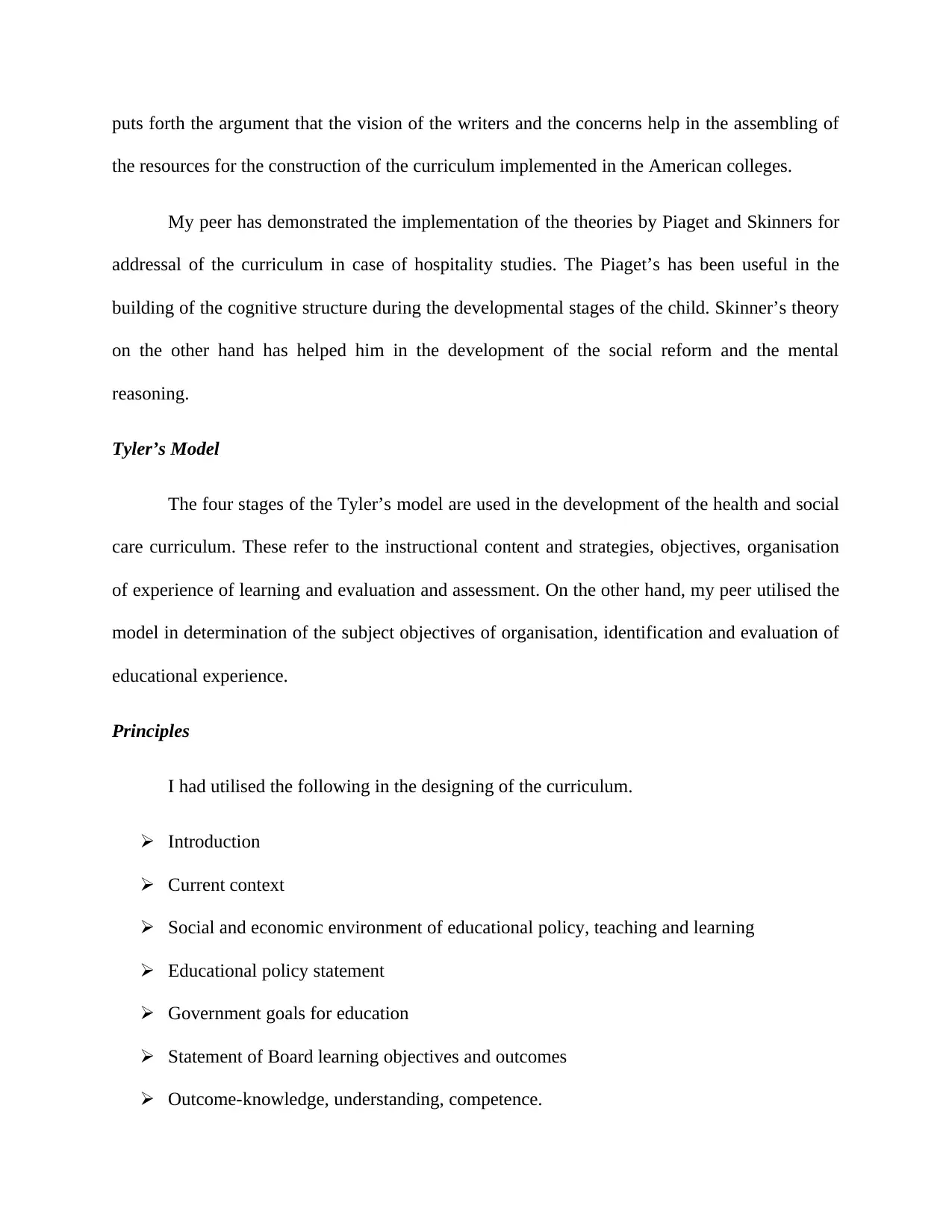
puts forth the argument that the vision of the writers and the concerns help in the assembling of
the resources for the construction of the curriculum implemented in the American colleges.
My peer has demonstrated the implementation of the theories by Piaget and Skinners for
addressal of the curriculum in case of hospitality studies. The Piaget’s has been useful in the
building of the cognitive structure during the developmental stages of the child. Skinner’s theory
on the other hand has helped him in the development of the social reform and the mental
reasoning.
Tyler’s Model
The four stages of the Tyler’s model are used in the development of the health and social
care curriculum. These refer to the instructional content and strategies, objectives, organisation
of experience of learning and evaluation and assessment. On the other hand, my peer utilised the
model in determination of the subject objectives of organisation, identification and evaluation of
educational experience.
Principles
I had utilised the following in the designing of the curriculum.
Introduction
Current context
Social and economic environment of educational policy, teaching and learning
Educational policy statement
Government goals for education
Statement of Board learning objectives and outcomes
Outcome-knowledge, understanding, competence.
the resources for the construction of the curriculum implemented in the American colleges.
My peer has demonstrated the implementation of the theories by Piaget and Skinners for
addressal of the curriculum in case of hospitality studies. The Piaget’s has been useful in the
building of the cognitive structure during the developmental stages of the child. Skinner’s theory
on the other hand has helped him in the development of the social reform and the mental
reasoning.
Tyler’s Model
The four stages of the Tyler’s model are used in the development of the health and social
care curriculum. These refer to the instructional content and strategies, objectives, organisation
of experience of learning and evaluation and assessment. On the other hand, my peer utilised the
model in determination of the subject objectives of organisation, identification and evaluation of
educational experience.
Principles
I had utilised the following in the designing of the curriculum.
Introduction
Current context
Social and economic environment of educational policy, teaching and learning
Educational policy statement
Government goals for education
Statement of Board learning objectives and outcomes
Outcome-knowledge, understanding, competence.
⊘ This is a preview!⊘
Do you want full access?
Subscribe today to unlock all pages.

Trusted by 1+ million students worldwide
1 out of 25
Your All-in-One AI-Powered Toolkit for Academic Success.
+13062052269
info@desklib.com
Available 24*7 on WhatsApp / Email
![[object Object]](/_next/static/media/star-bottom.7253800d.svg)
Unlock your academic potential
Copyright © 2020–2025 A2Z Services. All Rights Reserved. Developed and managed by ZUCOL.